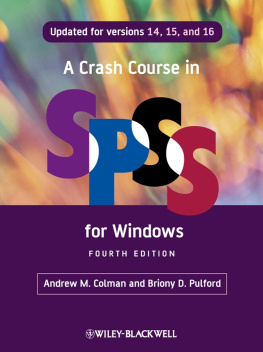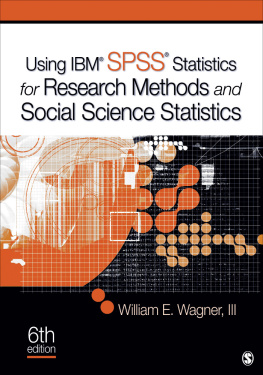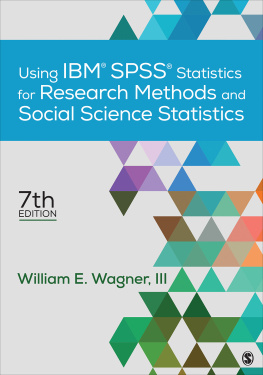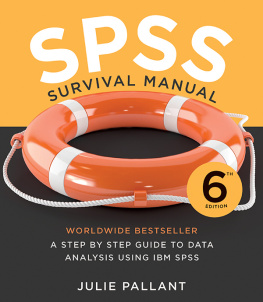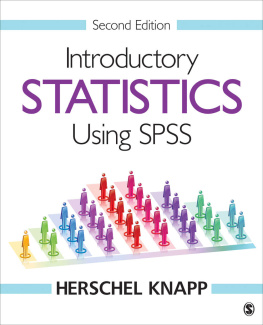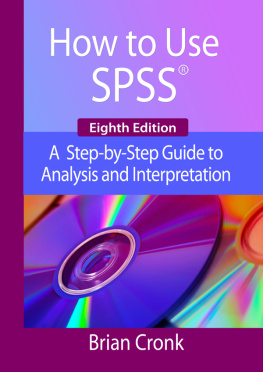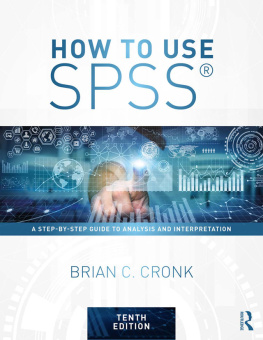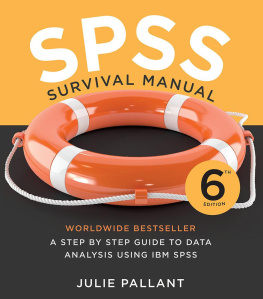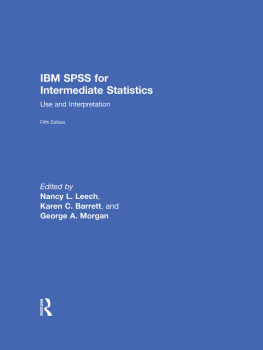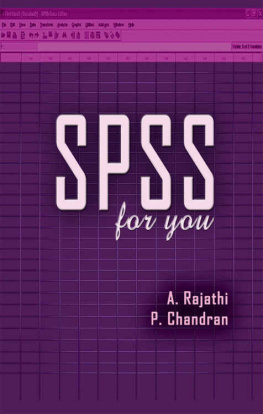Lawrence S. Meyers - Performing Data Analysis Using IBM SPSS
Here you can read online Lawrence S. Meyers - Performing Data Analysis Using IBM SPSS full text of the book (entire story) in english for free. Download pdf and epub, get meaning, cover and reviews about this ebook. City: Hoboken, year: 2013, publisher: Wiley, genre: Computer. Description of the work, (preface) as well as reviews are available. Best literature library LitArk.com created for fans of good reading and offers a wide selection of genres:
Romance novel
Science fiction
Adventure
Detective
Science
History
Home and family
Prose
Art
Politics
Computer
Non-fiction
Religion
Business
Children
Humor
Choose a favorite category and find really read worthwhile books. Enjoy immersion in the world of imagination, feel the emotions of the characters or learn something new for yourself, make an fascinating discovery.
- Book:Performing Data Analysis Using IBM SPSS
- Author:
- Publisher:Wiley
- Genre:
- Year:2013
- City:Hoboken
- Rating:5 / 5
- Favourites:Add to favourites
- Your mark:
Performing Data Analysis Using IBM SPSS: summary, description and annotation
We offer to read an annotation, description, summary or preface (depends on what the author of the book "Performing Data Analysis Using IBM SPSS" wrote himself). If you haven't found the necessary information about the book — write in the comments, we will try to find it.
3.2 THE IMPORTING PROCESSPART 2 OBTAINING, EDITING, AND SAVING STATISTICAL OUTPUT; CHAPTER 4 PERFORMING STATISTICAL PROCEDURES IN IBM SPSS; 4.1 OVERVIEW; 4.2 USING DIALOG WINDOWS TO SETUP THE ANALYSIS; 4.3 THE OUTPUT; CHAPTER 5 EDITING OUTPUT; 5.1 OVERVIEW; 5.2 CHANGING THE WORDING OF A COLUMN HEADING; 5.3 CHANGING THE WIDTH OF A COLUMN; 5.4 VIEWING MORE DECIMAL VALUES; 5.5 EDITING TEXT IN IBM SPSS OUTPUT FILES; CHAPTER 6 SAVING AND COPYING OUTPUT; 6.1 OVERVIEW; 6.2 SAVING AN OUTPUT FILE AS AN IBM SPSS OUTPUT FILE; 6.3 SAVING AN OUTPUT FILE IN OTHER FORMATS.
6.4 USING OPERATING SYSTEM UTILITIES TO COPY AN IBM SPSS TABLE TO A WORD PROCESSING DOCUMENT6.5 USING THE COPY AND PASTE FUNCTIONS TO COPY AN IBM SPSS OUTPUT TABLE TO AWORD PROCESSING DOCUMENT; PART 3 MANIPULATING DATA; CHAPTER 7 SORTING AND SELECTING CASES; 7.1 OVERVIEW; 7.2 SORTING CASES; 7.3 SELECTING CASES; CHAPTER 8 SPLITTING DATA FILES; 8.1 OVERVIEW; 8.2 THE GENERAL SPLITTING PROCESS; 8.3 THE PROCEDURE TO SPLIT THE DATA FILE; 8.4 THE DATA FILE AFTER THE SPLIT; 8.5 STATISTICAL ANALYSES UNDER SPLIT FILE; 8.6 RESETTING THE DATA FILE; CHAPTER 9 MERGING DATA FROM SEPARATE FILES.
9.1 OVERVIEW9.2 ADDING CASES; 9.3 ADDING VARIABLES; PART 4 DESCRIPTIVE STATISTICS PROCEDURES; CHAPTER 10 FREQUENCIES; 10.1 OVERVIEW; 10.2 NUMERICAL EXAMPLE; 10.3 ANALYSIS SETUP: CATEGORICAL VARIABLES; 10.4 ANALYSIS OUTPUT: CATEGORICAL VARIABLES; 10.5 ANALYSIS SETUP: QUANTITATIVE VARIABLES; 10.6 ANALYSIS OUTPUT: QUANTITATIVE VARIABLES; CHAPTER 11 DESCRIPTIVES; 11.1 OVERVIEW; 11.2 NUMERICAL EXAMPLE; 11.3 ANALYSIS SETUP; 11.4 ANALYSIS OUTPUT; CHAPTER 12 EXPLORE; 12.1 OVERVIEW; 12.2 NUMERICAL EXAMPLE; 12.3 ANALYSIS SETUP; 12.4 ANALYSIS OUTPUT; PART 5 SIMPLE DATA TRANSFORMATIONS.
CHAPTER 13 STANDARDIZING VARIABLES TO Z SCORES13.1 OVERVIEW; 13.2 NUMERICAL EXAMPLE; 13.3 ANALYSIS SETUP; 13.4 ANALYSIS OUTPUT; 13.5 DESCRIPTIVE STATISTICS ON ZNEONEURO; 13.6 OTHER STANDARD SCORES; CHAPTER 14 RECODING VARIABLES; 14.1 OVERVIEW; 14.2 NUMERICAL EXAMPLE; 14.3 ANALYSIS STRATEGY; 14.4 FREQUENCIES ANALYSIS; 14.5 RECODING AN ORIGINAL VARIABLE USING RANGES; 14.6 THE RESULTS OF THE RECODING; 14.7 RECODING AN ORIGINAL VARIABLE USING INDIVIDUAL VALUES; CHAPTER 15 VISUAL BINNING; 15.1 OVERVIEW; 15.2 NUMERICAL EXAMPLE; 15.3 ANALYSIS SETUP; CHAPTER 16 COMPUTING NEW VARIABLES.
This book is designed to be a users guide for students and other interested readers to perform statistical data analysis with IBM SPSS, which is a major statistical software package used extensively in academic, government, and business settings. This book addresses the needs, level of sophistication, and interest in introductory statistical methodology on the part of undergraduate and graduate students in social and behavioral science, business, health-related, and education programs. Each chapter covers a particular statistical procedure and has the following format: an example pr.
Lawrence S. Meyers: author's other books
Who wrote Performing Data Analysis Using IBM SPSS? Find out the surname, the name of the author of the book and a list of all author's works by series.



